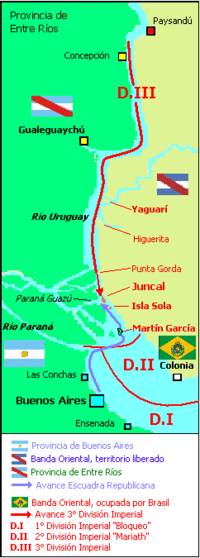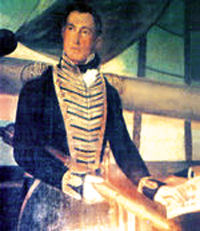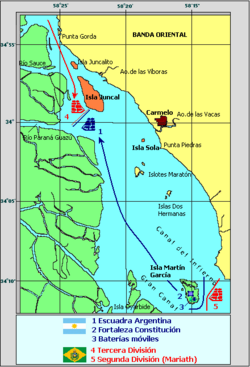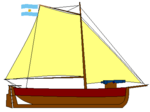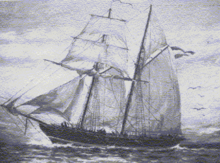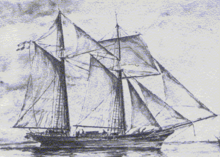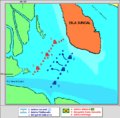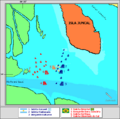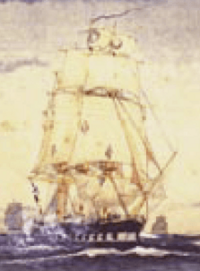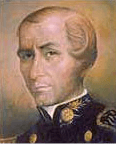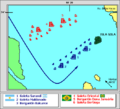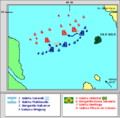Battle of Juncal facts for kids
Quick facts for kids Battle of Juncal |
|||||||
|---|---|---|---|---|---|---|---|
| Part of the Cisplatine War | |||||||
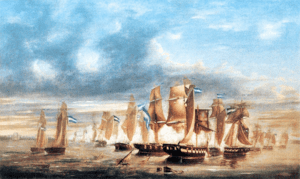 |
|||||||
|
|||||||
| Belligerents | |||||||
| Commanders and leaders | |||||||
| Strength | |||||||
|
1 brigantine |
1 brigantine |
||||||
| Casualties and losses | |||||||
| 12 ships captured 3 burnt casualties unknown |
No ships lost 17 killed in action |
||||||
The Battle of Juncal was a big naval battle during the Cisplatine War. It happened on February 8 and 9, 1827. The fight was between the navy of the newly independent United Provinces of the Río de la Plata (which is now Argentina) and the navy of the Brazilian Empire.
The battle took place in the waters of the Río de la Plata, near Juncal Island. The Argentine fleet was led by Admiral William Brown. The Brazilian fleet was commanded by Sena Pereira.
Even though both sides had similar numbers of ships, the Argentines won a huge victory. They were better at leading their ships and firing their cannons. Out of 17 Brazilian ships, 12 were captured, and 3 were burned. The Brazilian admiral's ship was also captured. The Argentines did not lose a single ship. This battle was the biggest naval win for Argentina in the Cisplatine War.
Why the Battle Happened
Brazil's Plan
In the second year of the Cisplatine War, Brazil had more ships than Argentina. So, they split their navy in the Río de la Plata area into three groups, called "divisions."
- The first group, "Bloqueio," was supposed to stop ships from entering or leaving Buenos Aires.
- The second group, "Oriental" or "Mariath," was meant to protect the coast of Uruguay. This group would also help the third group.
- The "Third Division," led by Sena Pereira, stayed in the Uruguay River. Their goal was to cut off supplies to the Argentine army. This army was fighting in a region called Cisplatina (which is now Uruguay). By controlling the river, Brazil hoped to attack Argentina from the side.
|
|
Argentina's Response
To fight these three Brazilian groups, Admiral William Brown of Argentina acted quickly. He put together a group of ships to go up the Uruguay River. His goal was to find and destroy the Brazilian Third Division.
At the same time, Brown wanted to stop Brazilian reinforcements. So, he made the island of Martín García stronger. He called it the "Fortress of the Constitution." He left other ships to defend the coast near Buenos Aires.
Brown was very brave. The force he sent was only as strong as the Brazilian Third Division, or even weaker. This meant the defense of Buenos Aires was at risk.
The Argentine ships sailed on December 26, 1826. They reached the Uruguay River two days later. They found the Third Division and chased them. Brown sent a captain, John Halstead Coe, to ask the Brazilians to surrender. But Sena Pereira took Coe prisoner and started the battle. The fight lasted until December 30. However, there was not much wind, and the river channel was narrow. This made it hard to move ships, so the battle ended without a clear winner.
Brown could not get into the narrow channel. He pulled back to Punta Gorda to wait for the Brazilians. He also sent orders for local fighters to cut off supplies to the Brazilian fleet. The Brazilians then moved further north to get supplies.
Brown was worried about the second Brazilian group (Mariath Division) attacking from behind. So, he went back to Buenos Aires to get more help for Martín García Island.
Getting Ready for Battle
On January 6, work began to fortify Martín García. The Mariath Division tried to attack the island with some ships. On January 18, Brown ordered his forces to meet the Brazilians twice. Both times, the Brazilians pulled back after some cannon fire.
Brown wanted to make the Third Division fight. But he also did not want the Mariath Division to join them or attack his ships from behind. Luckily, Brown had a great spy network. He got daily updates on the Brazilian fleet's movements. He learned that the Brazilian admiral, Rodrigo Pinto Guedes, had ordered Mariath to move south. Brown figured out that the Third Division would come down the river on February 7 to meet Mariath. Brown believed his forts at Martín García would be ready by then. This would let him block Mariath and force the Third Division into battle.
Work on the new fort was sped up. Brown himself helped with the building. On February 5, the fort was ready. Brown named it "Constitución." He told his soldiers that he expected the Argentine ships to meet Sena Pereira very soon.
By early February, the Third Division was getting supplies. On February 6, they were close to Nueva Palmira. The next day, Brown explained his plan and gave each ship a role. That night, the first Argentine ships reached the mouth of the Paraná Guazú river and waited for the rest of the fleet.
The Battle Begins
The Ships and Crews
Argentina (Admiral Brown)
Argentina had 15 ships, 73 cannons, and about 750 men.
- Sarandi (Brown's flagship)
- Balcarce
- Maldonado
- La Pepa
- Guanaco
- Union
- Uruguay
- 8 small gunboats
The Argentine fleet included three main ships: the schooner Sarandí (Brown's main ship), the schooner Maldonado (led by Francisco Drummond), and the brig Bergantín Balcarce (led by Francisco José Seguí). The fleet also had other schooners and eight gunboats. In total, they had 69 cannons and about 750 men.
Brazil (Sena Pereira)
Brazil had 17 ships and about 750 men.
- Oriental (flagship) - Captured
- Januaria - Captured
- Bertioga - Captured
- 4 schooners with 2 cannons each - Captured
- 4 gunboats with 2 cannons each - Captured
- 3 ships - Burned
- 2 others
The Brazilian fleet had 17 ships, including the schooner Oriental (Sena Pereira's main ship), the brig Bergantín Dona Januária, and other schooners and gunboats. They had 65 cannons and about 750 men. For the first time in the war, the two navies were almost equal in strength.
Fleets Meet
On the night of February 7, the Argentine ships were anchored near Juncal Island. At dawn on February 8, the Brazilian ships were seen coming down the river. Brown ordered his ships to get ready and form a battle line. His ship, Sarandi, was in the middle.
The Brazilian fleet kept moving until the wind stopped around 11:30 AM. They anchored about 1,000 yards from the Argentine line.
First Day of Fighting
February 8 was a stormy, hot, and humid day with light winds. Sena Pereira anchored his ships and sent a fire ship (a ship filled with flammable materials) towards the Argentines. But the Argentines quickly sank it with cannon fire.
At noon, Brown sent six of his gunboats forward. These boats had powerful 18-pounder cannons that could fire far. The Argentine gunners were also very skilled. After about two hours of firing, a sudden strong wind (called a sudestada) separated the fleets. They had to stop fighting.
The Brazilians were in a better position because the wind was blowing towards the Argentines. Sena Pereira tried to line up his ships for an attack. But their movements were messy. One ship got stuck, and another, Dona Januária, moved too close to the Argentine ships.
At 3:00 PM, the wind died down again. The battle became a long-range cannon fight. The smoke from the cannons made it hard to see. The sounds of the battle could be heard all the way in Buenos Aires. Another strong storm came, and the ships struggled to stay in place. One Argentine ship, General Balcarce, started to sink but managed to stay afloat. When the storm passed, a new wind came from the northeast. Sena Pereira tried to use this wind to move to a better position.
Again, the Brazilian ships moved badly. One ship had to be saved by others. The hospital ship Fortuna could not anchor and drifted towards the Argentine lines, where it was captured. When Fortuna was captured, John Halstead Coe, who had been a prisoner since December 1826, was freed. It was midnight before the Brazilian ships finally gathered in a messy group near Sola Island.
|
|
Second Day: Argentina Wins!
The Brazilian sailors were tired and could not make a good plan that night. At dawn, the Brazilian captains met on their flagship Oriental to decide what to do. Sena Pereira did not make a clear decision.
Admiral Brown, however, was ready. At 8:00 AM, with a southeast breeze, he ordered his ship Sarandí to raise a red flag. This was the signal for the Argentines to move into position and attack the Brazilians.
Sena Pereira then ordered his ships to form a battle line and drop anchor. But again, there was confusion. Some gunboats drifted away. Sena Pereira tried to shout orders, but it did not work. As the Argentines came closer in good order, he changed his mind. He ordered his fleet to raise anchors and try to move. Dona Januária, Bertioga, and Oriental moved towards the Argentines, but the rest of the Brazilian ships were scattered behind them.
These three Brazilian ships were quickly attacked by General Balcarce and the Argentine lead ships. The Argentine firing was very effective. A shot from General Balcarce destroyed Januária's front mast, causing a lot of damage. The ship was almost sinking. Sena Pereira ordered a small schooner to pull Januária away, but an Argentine ship blocked the way.
The attack was so fast and strong that the captain of Januária ordered his cannons to focus on the Argentines. He also told a team to try to sink their own ship, and he left with his crew in boats.
Meanwhile, Drummond, the commander of Maldonado, attacked Bertioga. A direct hit from an Argentine cannon knocked down Bertioga's main mast. The ship could not move and had to surrender after half an hour of fighting.
During this time, General Balcarce, led by Francisco Seguí, attacked Oriental. The intense cannon fire destroyed Oriental's cannons and caused 37 casualties, including Sena Pereira. Despite the losses, the Brazilians refused to surrender their flag, which was nailed to the mast. Finally, Argentine sailors boarded the ship, and Seguí accepted the Brazilian commander's sword as a sign of surrender.
With Oriental surrendered, the remaining Brazilian ships tried to escape. This turned the Argentine victory into a complete rout.
Brown moved his flag to General Balcarce. He ordered Sarandí and the gunboats to chase the fleeing Brazilian ships. When he boarded the captured Brazilian flagship, he was given the Brazilian commander's sword. Brown told Francisco Seguí, "You are the hero." Brown then took four of the captured ships to Martín García to fix them and prepare for any attack from the Mariath Division.
|
|
Martín García Island
Mariath's orders were to use his ten ships to get past the forts at Martín García. He was supposed to attack the Argentine ships from behind and help the Third Division.
Even though he could hear cannons firing far away, Mariath moved slowly and carefully. The main Argentine cannons were on the west side of the island. Mariath sent a schooner to check if the water on the east side was deep enough for his ships. The Argentine soldiers moved their mobile cannons to the east to defend against a possible landing.
But this move was not needed. The Brazilian ship got stuck in the shallow water. Mariath decided not to take the eastern route. He started a cannon fight with the main forts, but a storm forced him to stop.
Mariath then believed that the shallow water, bad weather, and strong forts at Martín García made it too risky to pass the island. So, on February 9, while the Third Division was being destroyed, the Mariath Division stayed far away and just watched. On February 10, Mariath finally decided to go back to Colonia de Sacramento.
The first news of the defeat reached the Brazilians on February 12. Eight survivors from Oriental arrived. Their stories were confirmed by other boats and, later, by the only surviving Brazilian ships, a schooner and a gunboat.
The Chase Continues
The day after the battle, the schooner Brocoio was chased and captured. Two other gunboats also ran aground and were captured by the Argentines.
At this point, the Third Division was left with only a few schooners and gunboats. All these remaining ships were fleeing north up the Uruguay River. The German captain of the schooner Itapoã took command of this small group. But they soon faced more problems. Three schooners got stuck and were burned by their crews to stop the Argentines from capturing them. The remaining ships, with 351 officers and crew packed on board, continued north. They planned to surrender to the authorities of the Province of Entre Ríos.
Admiral Brown quickly reorganized his forces. Since the Mariath Division had pulled back, Brown focused on the survivors of Juncal. On February 14, he returned to the Uruguay River with six ships. The next day, he learned that the Brazilian captain, Souza Aranha, had thrown his cannons into the sea and surrendered his ships to the governor of Entre Ríos. Brown anchored near Gualeguaychú and asked for the ships and prisoners to be handed over. However, the Entre Ríos authorities did not want to give them up. Brown then launched a successful land and sea operation. This led to the final capture of the remaining Brazilian fleet.
| Ships of the Third Division | ||
|---|---|---|
| Ship Name | What Happened | New Name (if captured) |
| Goleta Oriental | Captured | Renamed 29 de Diciembre |
| Goleta Bertioga | Captured | Renamed 9 de Febrero |
| Bergantín Dona Januária | Captured | Renamed 8 de Febrero |
| Goleta Brocoió | Captured in the Paraná | Renamed 30 de Julio |
| Cañonera Paraty | Captured in the Paraná | Renamed Cañonera N° 13 |
| Cañonera Iguapé | Captured in the Paraná | Renamed Cañonera N° 4 |
| Goleta 12 de Outubro | Captured at Entre Ríos | Renamed Goleta 18 de Enero |
| Goleta 9 de Janeiro | Captured at Entre Ríos | Renamed 11 de Junio |
| Goleta 7 de Setembro | Captured at Entre Ríos | Renamed 25 de Febrero |
| Cañonera Cananéia | Captured at Entre Ríos | Renamed Cañonera N° 7 |
| Cañonera Paranaguá | Captured at Entre Ríos | Renamed Cañonera N° 6 |
| Goleta Libertade do Sul | Burned | - |
| Goleta Itapoã | Burned | - |
| Goleta 7 de Março | Burned | - |
| Goleta Fortuna | Captured | Recaptured by Brazilian forces |
| Goleta Vitoria de Colonia | Survived | - |
| Cañonera Atrevida | Survived | - |
What Happened After
The Battle of Juncal was a huge loss for Brazil. Twelve of their ships were captured, and three were burned. Only two ships survived. This was the greatest victory for the Argentine fleet.
This win stopped Brazil from cutting off supplies to the Argentine army. It also prevented Brazil from using the Uruguay River to attack Argentina's coast. If they had succeeded, it could have caused big problems for Argentina. In Buenos Aires, Admiral Brown was celebrated with bonfires and music. He became the most popular person in Argentina.
Sena Pereira, the Brazilian commander, became Brown's prisoner. Brown respected his bravery. However, Pereira later escaped.
The Argentine naval victory at Juncal was quickly followed by land victories. These included the Battle of Ituzaingó (February 20) and the Battle of Carmen de Patagones (February 28). After these battles, the war slowed down. Brazil had been defeated in many places. But Argentina could not fully win because Brazil still had a strong naval blockade. Also, Brazil still controlled the two largest cities in the area, Montevideo and Colonia.
A British military historian named Brian Vale said that for Brazil's large navy, losing some of its smaller ships "made little difference to the ultimate balance of power." He also said that Juncal did not push Brazil towards peace. Later, at the Battle of Monte Santiago, Argentina lost two important ships. This showed that Brazil's navy was still much stronger at sea.
This situation continued until a peace agreement was signed. This agreement made the region of Cisplatina (the Eastern Province) an independent country, which is now Uruguay.
See also
 In Spanish: Batalla de Juncal para niños
In Spanish: Batalla de Juncal para niños


